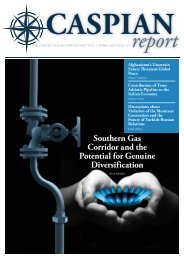Create successful ePaper yourself
Turn your PDF publications into a flip-book with our unique Google optimized e-Paper software.
general economic growth and is expected<br />
to continue, albeit at a slower<br />
pace. Other consumers from Israel<br />
to Kuwait and Dubai, are also minor<br />
importers with limited growth expectations.<br />
SUPPLYING A GROWING MARKET<br />
LNG production is currently dominated<br />
by a single giant player: Qatar.<br />
Unlike its Arab neighbours, Qatar<br />
has relatively limited oil reserves<br />
but massive gas reserves: 25.000<br />
bcm, equal to approximately 160<br />
years at current production levels. 2<br />
Due to its large internal production<br />
and significant international investments<br />
at the beginning of the 2000s,<br />
the country has dominated LNG<br />
markets for a decade. Exploiting its<br />
geographical position, Qatar is a major<br />
supplier to both Asian and European<br />
importers, partially rerouting<br />
its flows according to the evolution<br />
of final demand, a strategy which is<br />
not available to competitors reliant<br />
on pipelines. In 2013, Qatar exported<br />
104 bcm via its twelve LNG trains.<br />
Beyond Qatar, there are four medium-sized<br />
producers strongly focused<br />
on the Eastern Asian market:<br />
Malaysia, Australia, Indonesia and<br />
Nigeria. Malaysia and Australia<br />
each export more than 30 bcm of<br />
LNG, i.e. 10% of the global market.<br />
Their gas industries are growing<br />
and both are expected to increase<br />
their export volumes. Indonesia on<br />
the other hand is a mature producer<br />
which is striving to maintain its current<br />
export levels (25 bcm) and to<br />
supply its rapidly growing domestic<br />
market. Nigeria, by contrast, has a<br />
decreasing internal consumption<br />
and large reserves, but it is facing<br />
a deteriorating security environment,<br />
which prevents new international<br />
investments in upstream and<br />
export capacity. As a consequence,<br />
exports from the country are likely<br />
to remain at their current level (22<br />
bcm).<br />
Other major supplies of LNG are<br />
small producers which export exclusively<br />
through LNG. The largest<br />
is Trinidad and Tobago, a small insular<br />
state in the Caribbean, which<br />
exported 18 bcm in the 2013 and is<br />
a key player in the region. Other relevant<br />
small producers are Oman (11<br />
37<br />
CASPIAN REPORT, FALL <strong>2014</strong><br />
2.<br />
Energy Information Administration (EIA), <strong>Report</strong>: Qatar, 30/01/<strong>2014</strong> update.










